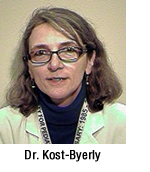president's message
Measuring Progress in Pediatric Pain Management
 By Sabine Kost-Byerly, MD
By Sabine Kost-Byerly, MD
The Johns Hopkins Hospital
Baltimore, MD
A few weeks ago I came across a very interesting study by Darin Correll, et al. from the Brigham and Women’s Hospital in Boston. “No evidence of real progress in treatment of acute pain, 1993-2012: scientometric analysis” (http://www.ncbi.nlm.nih.gov/pmc/articles/PMC3990387/pdf/jpr-7-199.pdf). It was disturbing and felt personal. In 1993, I first attended on the pediatric pain service. Is it really true that no progress has been made in acute pain management during my entire career?
In the article the authors assess pain management techniques’ “popularity” and “change” over time, based on overall publications, as well as “expectation” of importance by the frequency top journals in the field picked up the topic. The authors concluded that by 2008-2012, medications (bupivacaine and acetaminophen) and techniques (PCA and regional analgesia) introduced 30-50 years earlier were most “popular.” Dexamethasone seemed to be the only drug moderately notable for “change” and “expectations.” These findings were contrasted with several large surveys demonstrating that severe pain continues to be experienced by a large number of patients. Thus, they concluded that medications or techniques introduced for acute pain management within the last 20 years failed to make any difference for patient outcomes.
The authors do not specifically address pediatric pain management. Continuous opioid infusions and regional anesthesia beyond the single shot kiddie caudal were introduced in the late 1980’s; pain management in frail infants took off after Sunny Anand’ s and Paul Hickey’s article in the NEJM in 1992 http://dx.doi:10.1056/NEJM199201023260101. A robust pediatric pain service has worked on improving care at Johns Hopkins since then. Nevertheless, like in many other institutions, it remains difficult to prevent and treat acute pain in all locations throughout the Children’s Center. Fragmented care provided by many specialists, focuses on procedural efficiency, hand-off’s from one call team to the next, and ever-increasing time spent with electronic documentation. Patient-centered care remains but a vision.
Although there is no comparable study examining pediatric pain treatments we know that children in hospitals continue to experience significant pain. Cornelius B. Groenewald et al. noted moderate to severe pain in 27% of the patients admitted to the Mayo Eugenio Litto Children’s hospital (Pediatr Anaesth 2012;22:661-8 http://dx.doi:10.1111/j.1460-9592.2012.03807). The prevalence was even higher (44%) in children on surgical services. Fewer than 10% of these patients received regional anesthesia, a significant number (40%) had access to opioids only on an as needed basis. Lori Kozlowski et al. (2014) confirmed these findings at the Johns Hopkins Children’s Center (Pain Manag Nurs 2014;15:22-35 http://dx.doi.org/10.1016/j.pmn.2012.04.003 ): 40% of the patients reported moderate to severe pain. Rare physician documentation of pain scores and frequent “as needed” analgesic dosing were seen as obstacles to optimal pain management.
Thus, it appears that we still don’t have medical center-wide commitment to optimal pain management in children. How can we get there? Here are a few considerations: A biopsychosocial model for acute pain may help to develop more comprehensive treatment approaches, beyond pharmacological analgesic techniques. Inclusion of behavioral and physical interventions for patients (pre-procedure web-based distraction training?) and guardians (neck and shoulder massage, relaxation group sessions?) may limit procedural anxiety and catastrophizing. Of course, getting to know the patient for more than 5 minutes in the preop area or PACU would be essential. Could the currently ASA-proposed perioperative surgical home model aligned with the AAP-envisioned pediatric medical home offer a better chance for providing individualized patient-centered care and significantly improving outcomes in pediatric pain management?
I hope to hear your thoughts on this topic. If you have developed a model of success at your hospital please share it with us. We are all learners committed to the well-being of children.

